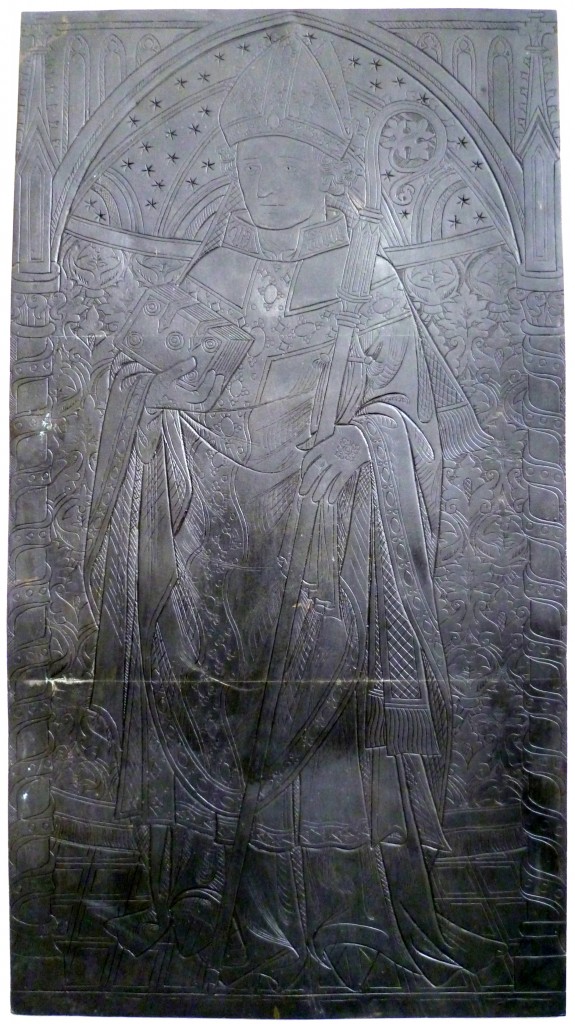Portfolio of Brasses
Each month we feature an article about a brass of particular interest.
If you would like to submit an article for this feature please contact:
-
John Prideaux
County: Worcestershire
Date: 1550
September 2021
It is entirely fitting that John Prideaux is commemorated by a brass as he had provided brasses for his parents and other members of his family during his own life. The account by Thacker of his brass tells us that he had composed the Latin inscription himself leaving only the date of his d ath and his age to be added. While the inscription outlines his career it says nothing of his marriages or children. It also omits his clerical appointments prior to being made bishop of Worcester.
John Prideaux was born on 17 September 1578, the fourth son of...
read more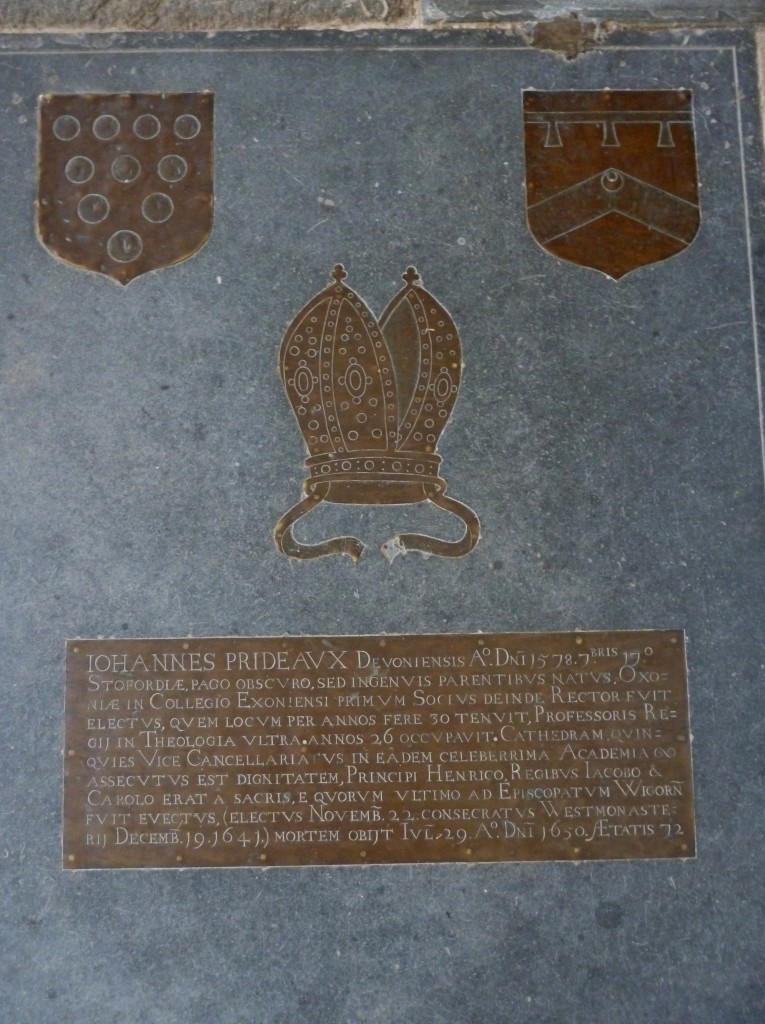
-
Richard Folcard
County: Suffolk
Date:
August 2021
The brass of Richard Folcard lies at the entrance to the south chancel of Pakefield church on the Suffolk coast, just south of Lowestoft. He was rector of the southern part of the church.
Pakefield church was a dual church: for hundreds of years it was divided in two, the southern half being dedicated to All Saints, the northern to St Margaret. The two halves were separated by a wall and constituted two churches until united in the eighteenth century.
The church retains another brass, to John Bowf and his wife Agnes. It is mounted on the north wall in a...
read more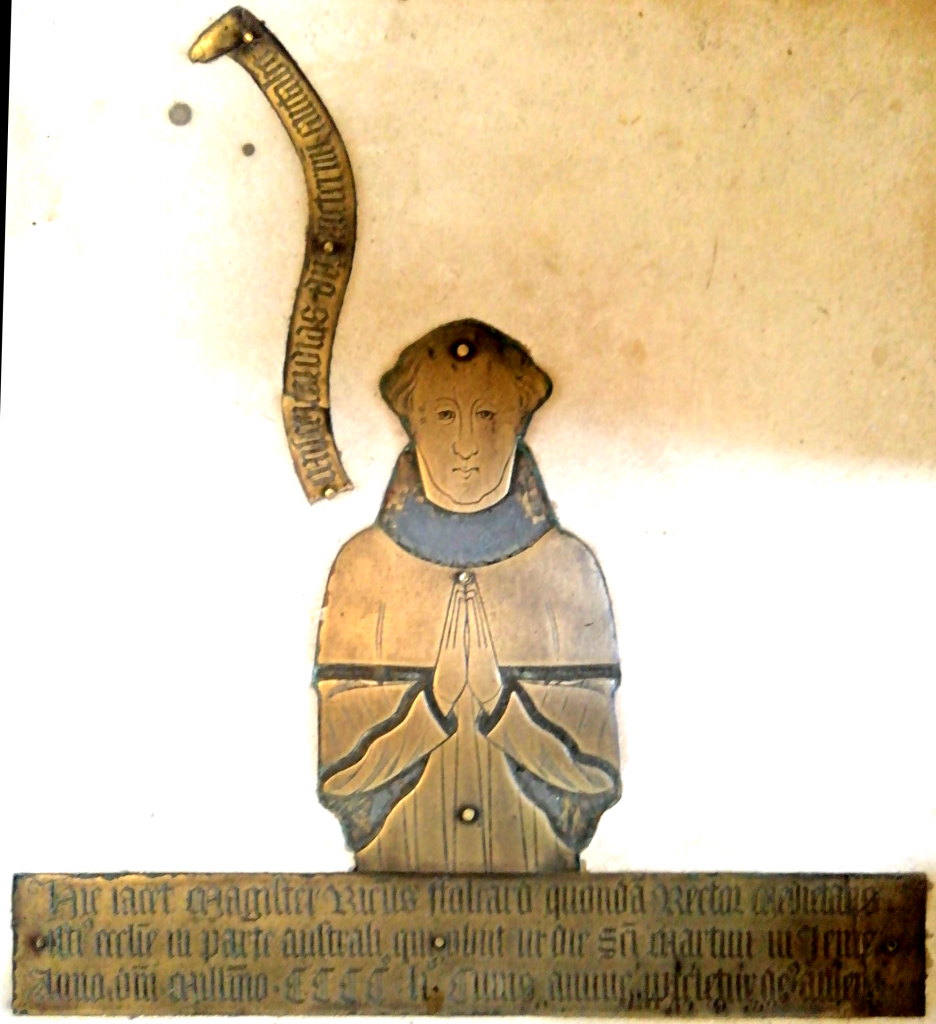
-
Roger and Mary Gyfford
County: Buckinghamshire
Date: 1542/3
June 2021
Middle Claydon is the site of Claydon House, well-known as the home of the Verney family and built in the eighteenth-century. Earlier Verneys are commemorated by monuments in the church but two brasses and an alabaster tomb commemorate members of the Gyfford family. While the figure brass of Isabel Gyfford, who died in childbirth in 1523, is of a decent but unremarkable size for the period (470mm high), those commemorating her parents Roger. died 1542, and Mary are both remarkably large, Roger's being 1535mm and Mary's marginally smaller (1492mm). Part of the explanation is of course the availability of...
read more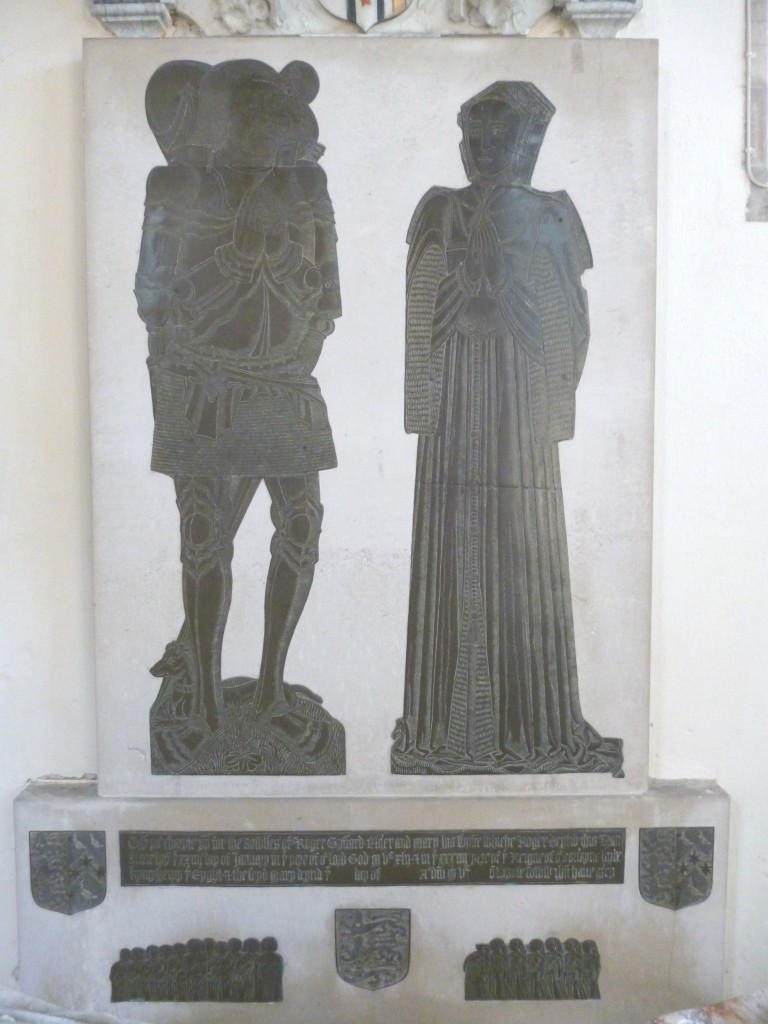
-
Philip & Margery Bosard
County: Norfolk
Date: 1490
July 2021
Philip Bosard is termed a gentleman on the brass at Ditchingham, Norfolk that commemorated him and Margery, his wife, after his death on 16 December 1490 but it was a rank that he had only latterly achieved. Actions in the Court of Common Pleas in 1455 and 1475 called him a yeoman. In the 1460s and 1470s Bosard was John Hopton's farmer of the manor of Pirnhow. Pirnhow manor is in Ditchingham, just north of the town of Bungay in Suffolk on the other side of the River Waveney. John Hopton had come into a large inheritance in 1430...
read more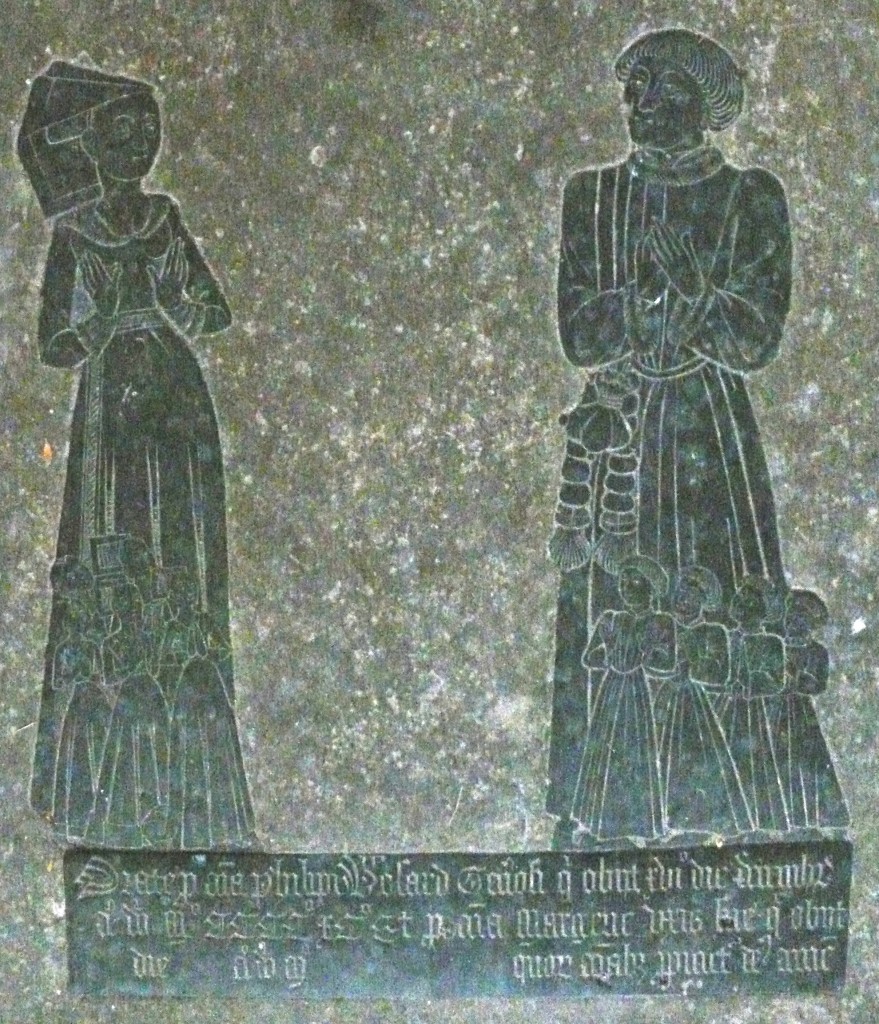
-
John Newdegate
County: Middlesex
Date: 1545
May 2021
The brass of John and Anne Newdegate has been discussed in print by the society's then president, Dr H K Cameron in the early 1960s and more recently by Robert Hutchinson and Bryan Egan. It is situated on the south wall of the chancel at Harefield. The accompanying photographs were taken when the MBS visited the church in March 2010. As they show, the brass is on the back wall of a canopied Purbeck marble monument that also has a chest with shields set in lozenges. On the top of the chest is an indent for a shroud brass.
read more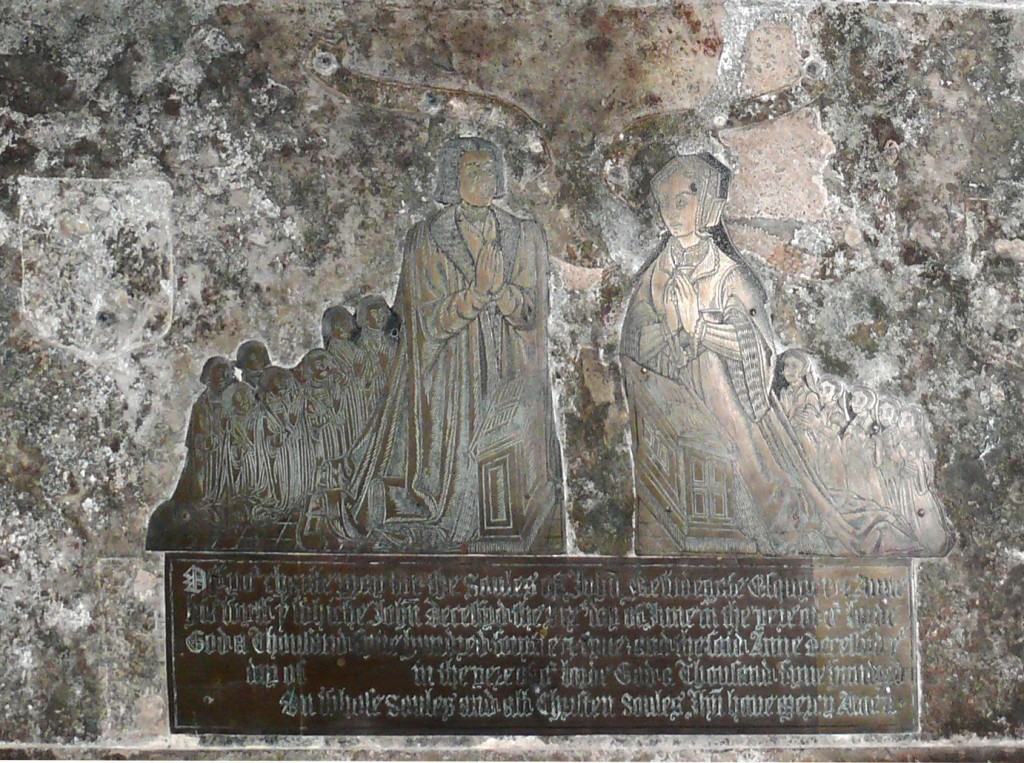
-
Alexander Inglisshe
County: Suffolk
Date: 1520
April 2021
Only one brass remains in the church of Campsea Ash, Suffolk. It commemorates Alexander Inglisshe, the parish priest. It consists of the three components from a much larger composition, namely are the figure, the canopy over it and an inscription beneath it. The side shafts of the canopy and a marginal inscription are lost but some of the pitch used to fix them remains. The latter, at least, remained in place in the very early 1600s when it was recorded by the anonymous author of the Chorography of Suffolk along with two other brasses: a figure of a woman...
read more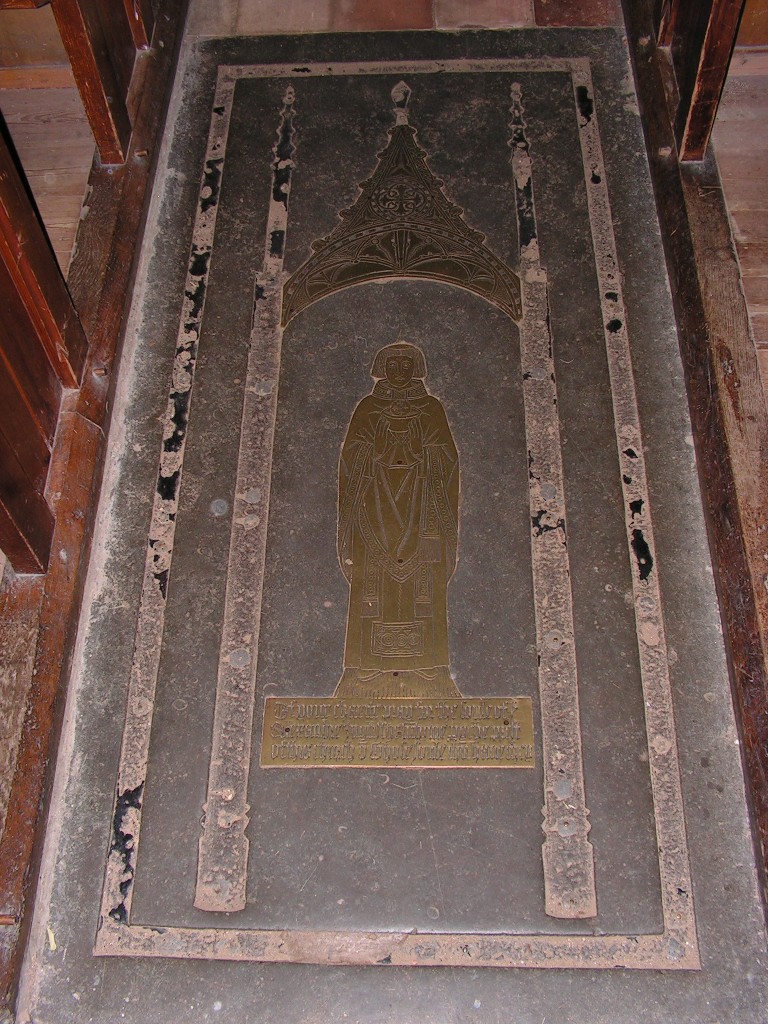
-
Richard Freston
County: Suffolk
Date: 1616
March 2021
Mendham lies on the south bank of the River Waveney, the boundary between Norfolk and Suffolk. In the time of the Norfolk historian Francis Blomefield the parish was a large one and had parts which lay in Norfolk on the north bank of the river, namely the hamlet of Needham and parts of the town of Harleston. For this reason Blomefield included Mendham in his History of Norfolk. Needham had a chapel of ease, now its parish church.
The Freston family was one that benefited from the upheavals of the Reformation. Edward VI granted Wichendons manor in Mendham and all...
read more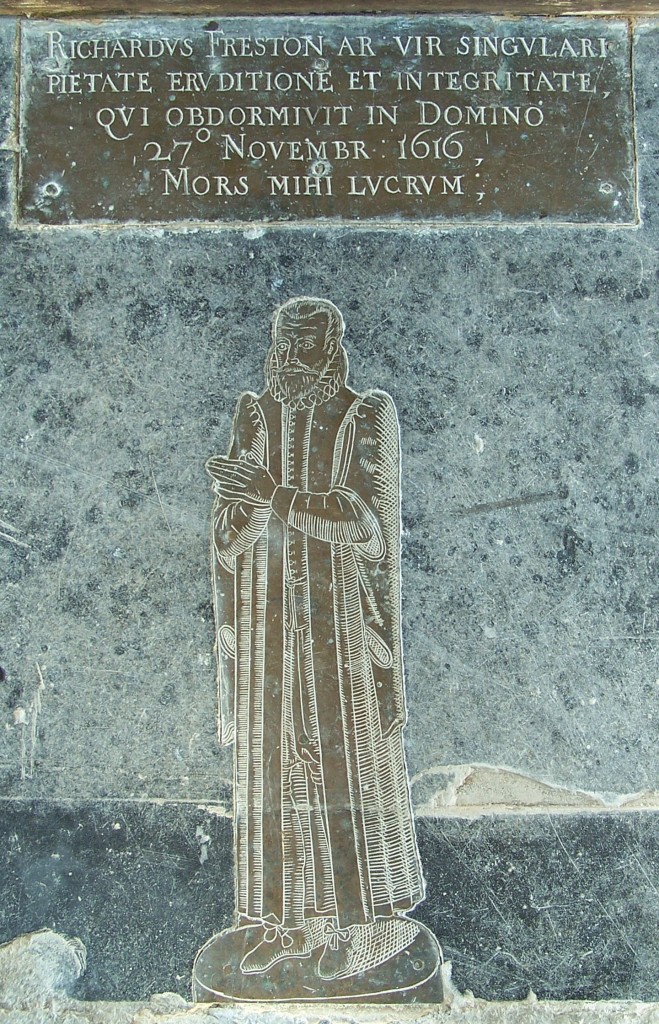
-
Sir John Russell
County: Worcestershire
Date: 1405
February 2021
The workshops producing monumental brasses established in the years after the devastation of Black Death usually produced brasses that fit neatly into stylistic sequences. This was first demonstrated by JPC Kent in his analysis of military brasses and has been confirmed by later scholars like Robin Emmerson. When London style A ended it was replaced by London style D, as B was later by F. The demand for brasses as memorials meant that other workshops like C and E were able to come in and compete with the established ones. During the period that these workshops operated, when a...
read more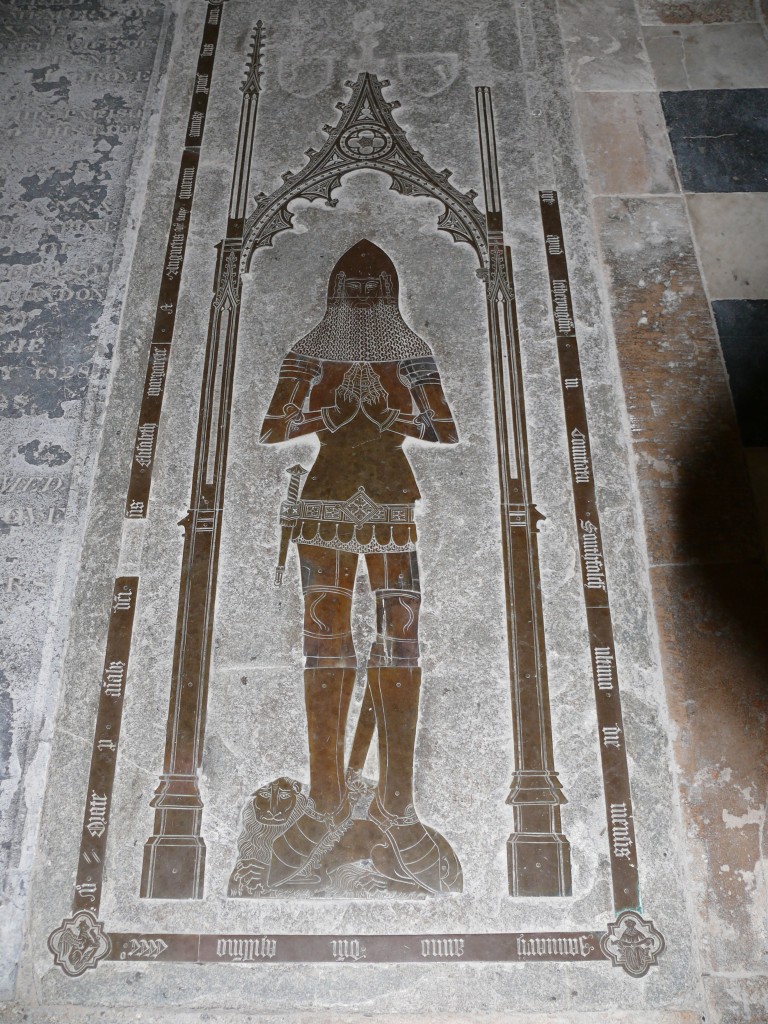
-
Karsten Middeldorp
County:
Date: 1561
January 2021
This brass relates to the Lübeck bell & cannon founder Karsten MIddeldorp and his wife Dorothea, engraved in 1562. It measures 95 x 65 cm and is located on the east side of the third of five pillars separating the central and northern aisles of the 3-aisled Brick –Gothic hall church of St Jakobi, in the Koberg district of Lübeck1. Its original location is apparently unknown and there is no evidence of its slab having survived.
It is designed in the early Renaissance classical style, with Corinthian columns topped with an entablature containing foliage motifs on either side of a...
read more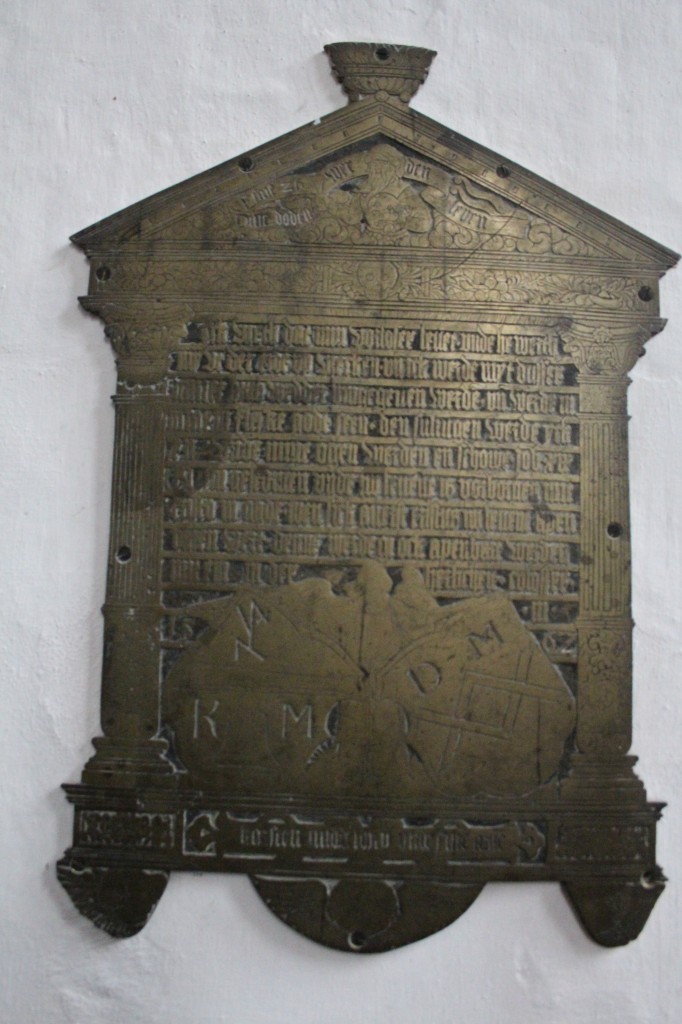
-
Richard and Joan Foxwist
County:
Date: 1500
May 2012
Medieval memorial brasses are surprisingly rare in Wales: J. M. Lewis lists seven before 1550, plus one from St Davids which has been lost, a couple of indents and a few brass letters. This is fewer than many English parishes. Those that survive are mostly typical products of the London workshops. There are some idiosyncratic ones, though. Sally Badham has said that one of these, the memorial to Richard and Joan Foxwist in Llanbeblig (the old parish church of Caernarfon), is like nothing else she has ever seen. She suggested that it might...
read more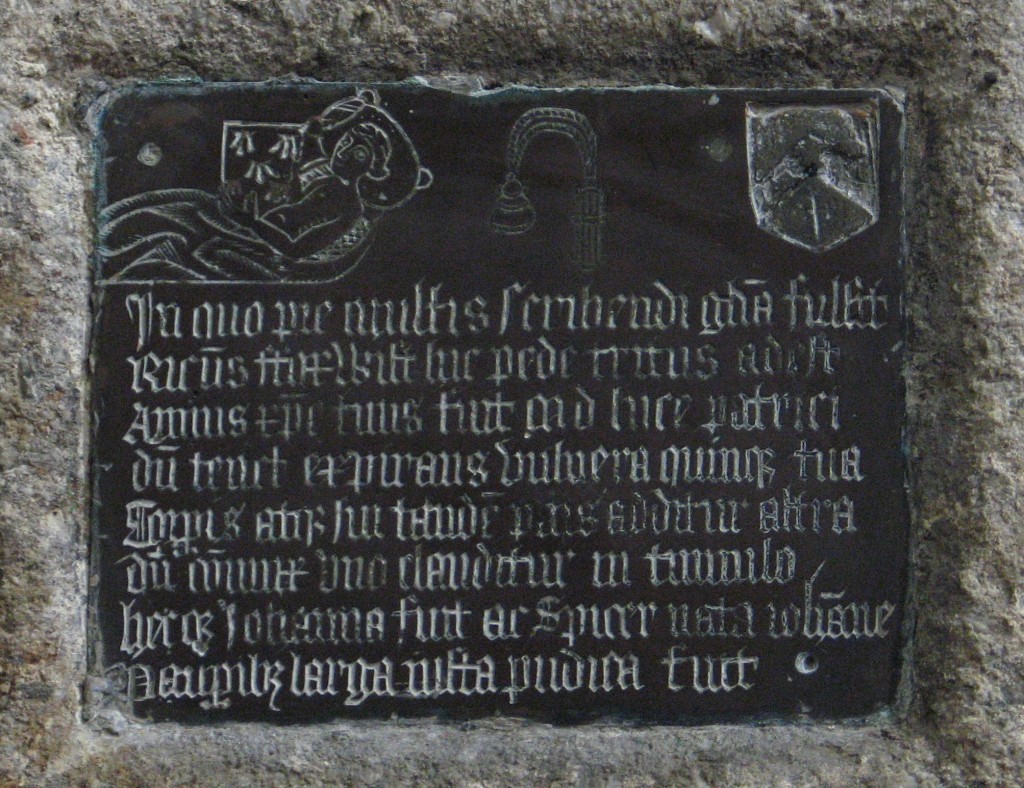
-
Johan von Heringen
County: Thuringia
Date: 1595
April 2012
When the Rev W F Creeny visited Erfurt Cathedral before 1884, he found the brass of Johan von Heringen on the floor outside the chancel gate. In 1900 it was moved to the cloister along with other brasses and slabs. This had the advantage of preserving what was left of the low relief carving on the slab, which Creeny described as 'worn away'. This monument is actually a composite one, showing the upper part of the figure in brass and the lower cut into the slab itself. The main outlines of the portion of the figure on the slab...
read more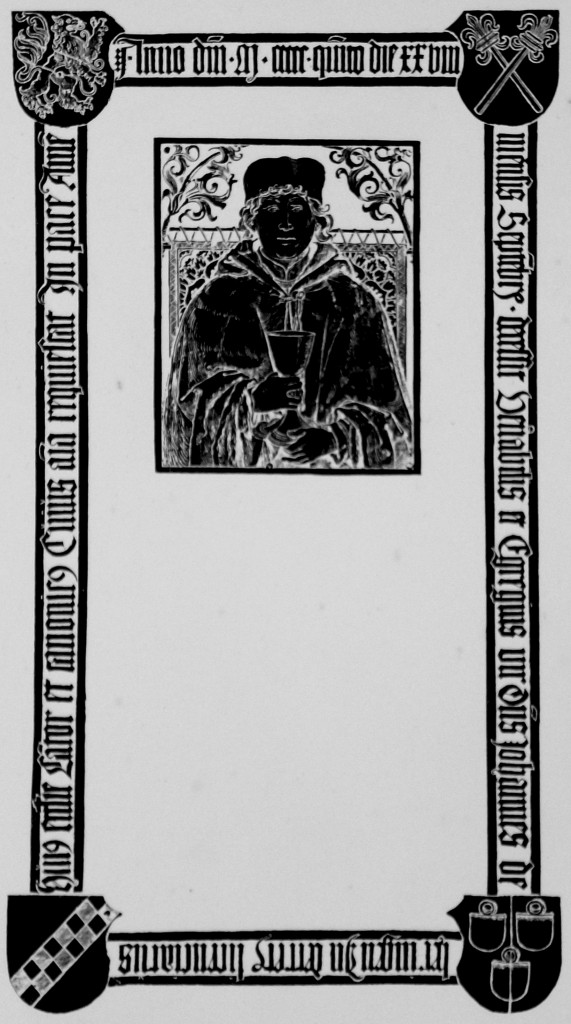
-
John Browne
County: Suffolk
Date: 1581
March 2012
On 26 May the Society will visit Suffolk on an excursion. We will stop for lunch at Halesworth, a small market town, and examine the brasses there. One of these commemorates John Browne, who according to his inscription led a 'quiet life' before his death in 1581.
The history of his brass has been rather more eventful. According to the modern brass plate to which the original inscription is now joined by a hinge, in 1825 the remains of his brass were fished out of the River Waveney, which divides Suffolk from Norfolk, at a spot called the 'roaring arch'...
read more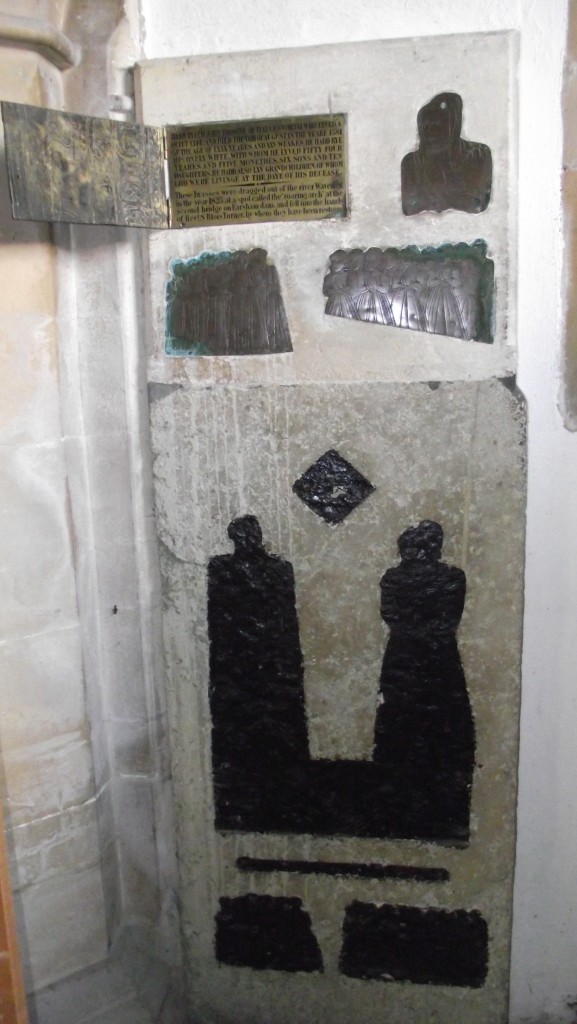
-
Thomas Tyard & Philip Tenison
County: Norfolk
Date: 1505/6 & 1660/1
January 2012
We begin the year with two brasses, both set in the same slab in the church of Bawburgh, not far from Norwich.
Thomas Tyard, as his inscription tells us, was a Bachelor of Sacred Theology and sometime vicar of this church. He was a fellow of Corpus Christi College, Cambridge, in 1478 and became vicar of Bawburgh in 1493. He spent the years between 1484 and 1492 in King's Lynn. In 1484 he was appointed master of the charnel house at Lynn, an establishment also known as the Old Chantry, which was part of St Margaret's church. There are Lynn...
read more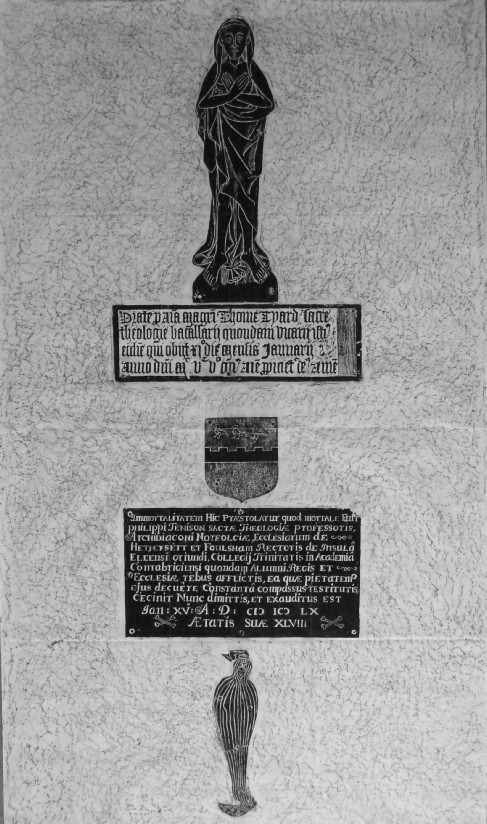
-
Stillborn Son of the Elector Johann-Georg I of Saxony
County: Saxony
Date: 1608
December 2011
Brasses are normally monuments to named people. This month’s brass is perhaps unique in elaborately commemorating someone who was never christened, and indeed never lived – except in an anti-abortionist sense. Elsewhere1 I have mentioned a visit to East Germany, which our late President, Malcolm Norris, succeeded in arranging in the mid-1950s. I went along too, as his German/English interpreter. Malcolm was far too kind to say what he really thought of my efforts to rub brasses, so he always explained apologetically that he’d...
read more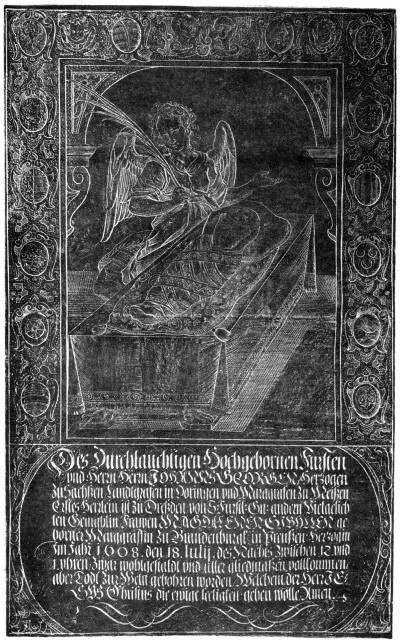
-
Sir William Burgate
County: Suffolk
Date: 1409
November 2011
St Mary’s, Burgate, is the quintessential Suffolk church with a great medieval tower, in an ordinary village surrounded by hedgerows and barley fields. Entering the church, the eye is led inexorably towards the fine tomb chest, with a brass as its cover, which is set immediately in front of the altar and dominates the chancel. This is the monument of Sir William Burgate, lord of the manor (d. 1409), and his wife, Eleanor, who survived him by at least...
read more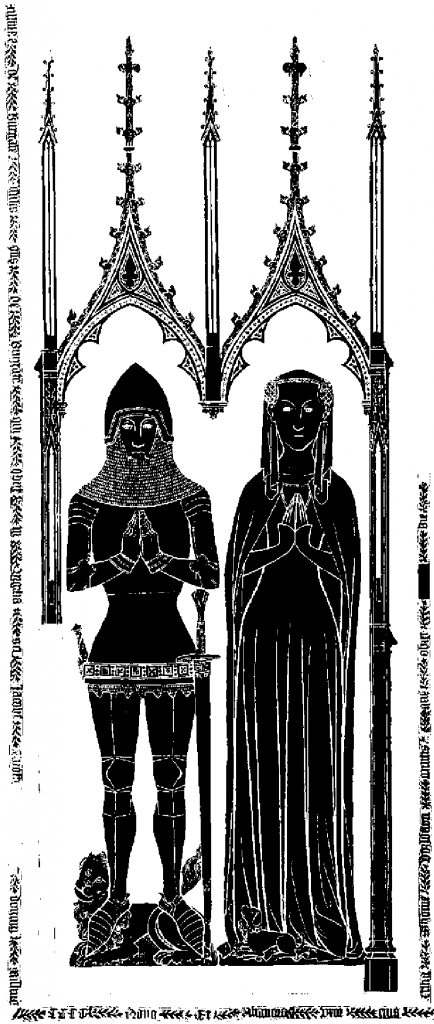
-
Susanna Gartside
County: Lancashire
Date: 1688
October 2011
In the first volume of the Victorian novel Scarsdale, the author, Sir James Kay-Shuttleworth, has Barnabas Collier go into the parish church during the Rochdale Rushbearing for a few moments of quiet meditation and read the lines at the end of the inscription of the Gartside brass:
“Lilia cum spinis florent, post funera virtus,
Nam bene viventi vita beata manet.”
This, in Barnabas's mood, was an inscription to detain him in long reverie.
The inscription on the brass translates thus:
Here lies buried Susanna Gartside, wife of Gabriel Gartside of Rochdale and daughter of James Gartside of Oakenrod,...
read more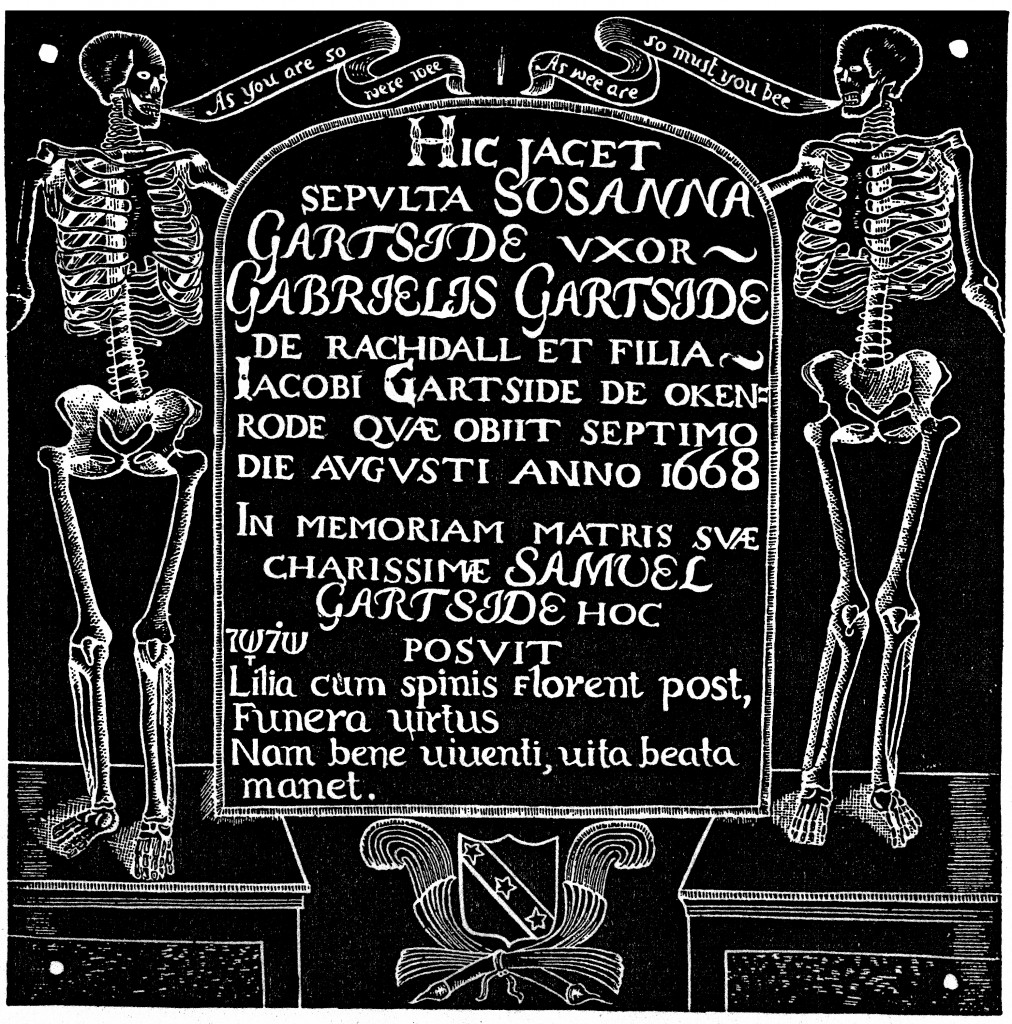
-
Joost van Amstel van Mijnden
County:
Date: 1554
September 2011
The memorial brass showing Joost van Amstel van Mijnden and his family (Museum Catharijneconvent, Utrecht) is one of a handful of memorial brasses from the Northern Netherlands to have survived.i The brass was made shortly after Joost van Amstel van Mijnden’s death in 1554. At first sight the image seems conventional for the Northern Netherlands. Many memorial paintings and sculptures featured donor portraits of a family, and this brass depicts a couple with their...
read more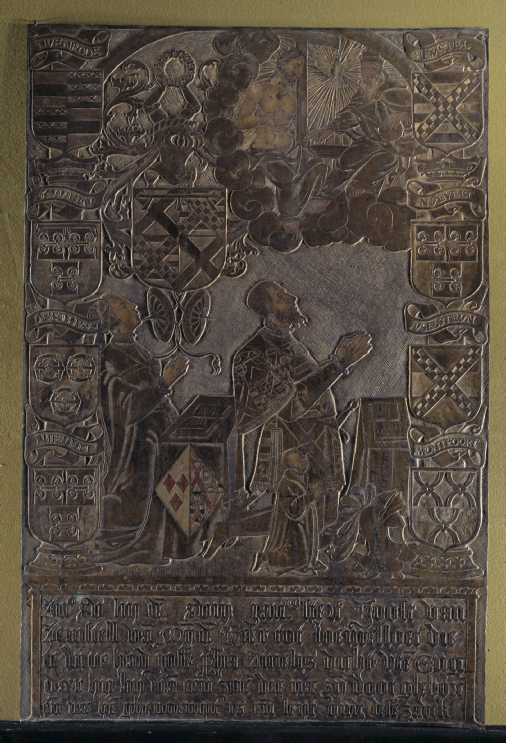
-
Thomas Cawarden
County: Staffordshire
Date: 1592/3
August 2011
The decoration of the north aisle of Mavesyn Ridware parish church, which contains Thomas Cawarden's monument, is most extraordinary. This aisle was the burial place of the lords of the manor over several centuries and contained a number of monuments. Stebbing Shaw's History and Antiquities of Staffordshire (1798-1801) has a great deal to say about the successive lords, and has an engraving of the aisle viewed from the west and another looking north from the east, illustrating the Cawarden tomb in its setting in the centre of the east end and showing other slabs on the floor. Stebbing Shaw also...
read more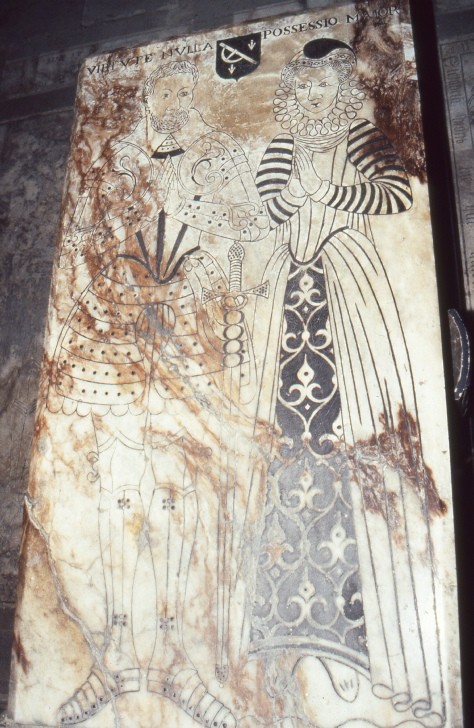
-
Catherine Verney
County: Warwickshire
Date: 1657
July 2011
The period of the Commonwealth saw the end of any coherent production of figure brasses in England until the Victorian revival. The production of brasses during the latter half of the seventeenth century was very patchy. Inscription brasses continued to be produced in some numbers in the north and west of the country by engravers such as the Mann brothers, Thomas and Joshua, in York, and there were occasionally quite ambitious compositions, such as the inscription and achievement to Martha Bright, 1663, set under a large arch, in Sheffield Cathedral. However, in the east and south-east, the black 'marble'...
read more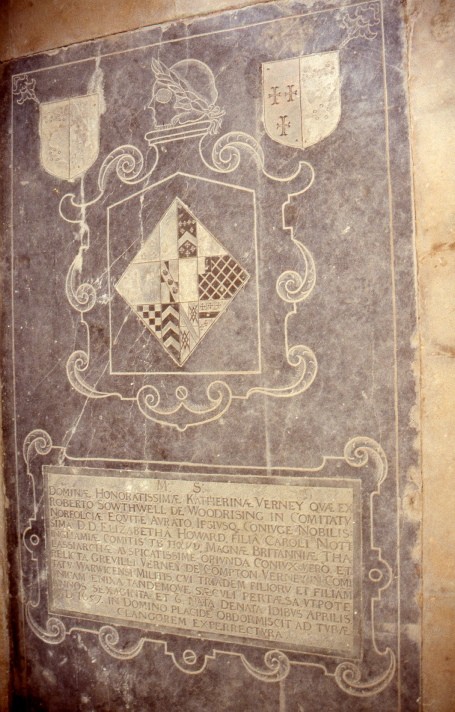
-
Bishop Johann II von Schleinitz
County:
Date: 1434
June 2011
The collegiate church of Zeitz is within the walls of the schloss, an unusual situation for a major church. Johannes II von Schleinitz was bishop of nearby Naumberg and two other brasses in the church at Zeitz likewise commemorate bishops of Naumberg. After studying for his doctorate at the University of Leipzig, he was dean of Bautzen, canon of Meissen, dean of Zeitz and in 1422 Bishop of Naumberg. When he died in 1434, he was succeeded as bishop by his cousin, Peter non Schleinitz, the subject of another brass at in the choir. Malcolm...
read more